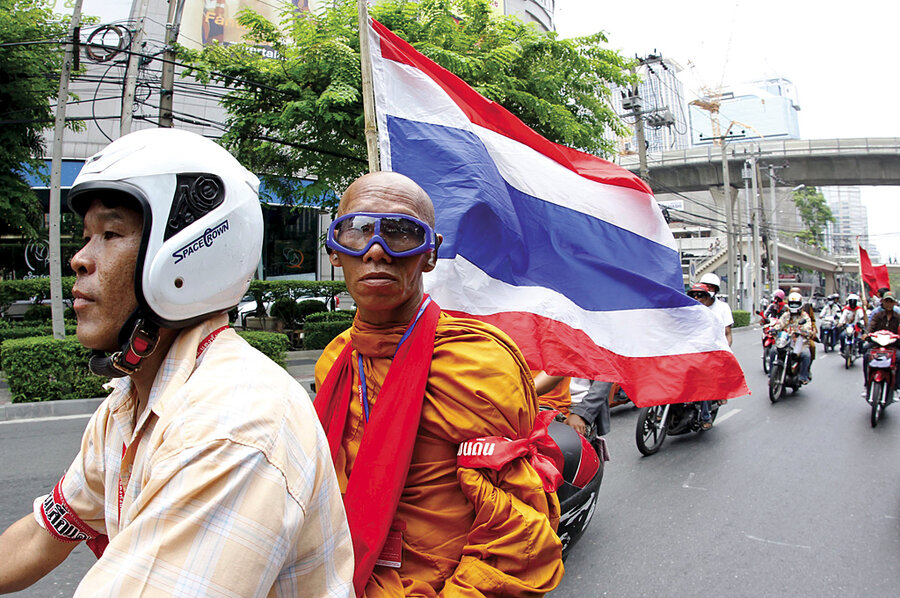The fuel behind Thailand red-shirt protesters' fire
Loading...
| Bangkok, Thailand
Antigovernment "red shirt" protesters have laid siege to key parts of Bangkok since March 12, the latest unrest in nearly five years of turmoil that have shaken Thailand's political foundations. On Tuesday they accepted the government's roadmap for reconciliation – which could bring elections by November – but said they want additional concessions and will not yet abandon their sit-ins. Commentators have warned of civil war if no political compromise is reached, in a country whose modern history is strewn with coups, countercoups, and half-baked constitutions.
Who are red shirts, yellow shirts?
The red shirts, or the United Front for Democracy against Dictatorship (UDD), emerged after a 2006 coup to oppose the junta. They are supported by former Prime Minister Thaksin Shinawatra, who lives in exile and has been convicted of corruption.
IN PICTURES: Top 10 unusual protests
UDD backers are mostly rural and working-class. Many want to see the return of Mr. Thaksin and his populist economic policies. They reject current Prime Minister Abhisit Vejjajiva as illegitimate and unelected.
The movement has staged rallies in Bangkok of 100,000-plus. Critics say they are paid pawns in Thaksin's scheme to regain power. The UDD also has a shadowy armed wing of former and active security personnel. It has allies in the security forces.
The yellow shirts, or People's Alliance for Democracy (PAD), laid the groundwork for the 2006 coup. A conservative alliance of Bangkok and southern factions, it staged mass rallies against Thaksin in 2006, then reappeared in 2008 to oppose another elected pro-Thaksin government. The second round included a seizure of two Bangkok airports.
The PAD is supported by middle- to upper-class voters, and is stridently royalist. Its rallies are mostly peaceful, but it recently urged martial law to disperse the red shirts.
What is behind the cycle of protests?
Street protests have shaped modern Thai politics. In 1973, students in Bangkok overthrew a military dictatorship, with support from King Bhumibol Adulyadej, a constitutional monarch. In 1992, protesters faced down an unpopular junta leader. King Bhumibol intervened to mediate after troops killed unarmed protesters.
The rise of Thaksin, a rich businessman who built a mass political base, changed the equation. Instead of opposing a dictator, the PAD mobilized against a popular, elected leader. When it succeeded, its rivals took to the streets and used the same tactics.
The result is a cycle of protests and counterprotests that has polarized public opinion along class and regional lines and undermined parliamentary democracy. The elderly Bhumibol's influence has waned. The red shirts are growing to resent him.
How strong is Thai democracy?
In 1997, Bangkok adopted a liberal Constitution that guaranteed civil rights. But after Thaksin was elected in 2001, he began to undo independent checks on his government.
The military later tore up the Constitution and drafted a more conservative one.
Some analysts say democracy has been impeded by royalist elites, who backed the coup against Thaksin. "Bangkok elites can't understand what has changed in Thailand in the last few decades. They can't adjust," says Nidhi Eeoseewong, a retired historian in Chiang Mai.
Many intellectuals and middle-class urbanites cheered the coup, partly for fear of redistributive economic politics, says Federico Ferrera, of the National University of Singapore. That stops them from supporting the poorer red shirts, despite shared goals such as social justice and democracy. "Bangkok's middle classes have been told repeatedly … that the equal participation of 'the great unwashed' in ... government will largely take place at their expense," he says.
Is this an ideological struggle, and how does it affect Southeast Asia?
It's not really ideological. The red shirts are a democratic mass movement, as are the yellow shirts, to a lesser extent. Politicians and money shape both groups, but they are essentially battling to define the parameters of Thai democracy. Neither aims to reverse the free-market economy.
What is at stake is the monarchy. The PAD accuses Thaksin of wanting to replace it with a presidency, a charge he denies. The military has used defense of the monarchy to justify political interventions. Many expect royal influence to wane after Bhumibol's passing; libel laws and taboos make such debate difficult.
Prolonged instability is alarming trade partners like Japan and the United States. A reversion to military rule would tilt the balance within the 10-member Association of Southeast Asian Nations, which is struggling to find common ground in tackling the oppressive junta in Burma (Myanmar). But it may be preferred by some allies to continued paralysis.
Who are Thailand's power brokers?
The palace and military and business elites are key. But the polarization of recent years has affected how much influence these groups wield – creating more democratic space, but also leaving a vacuum. The Army is divided over how to handle popular dissent. It also stumbled badly after seizing power in 2006. But it remains an essential player. "It's going to take a long time to get them back in the barracks again," says James Klein, country director for the Asia Foundation.


